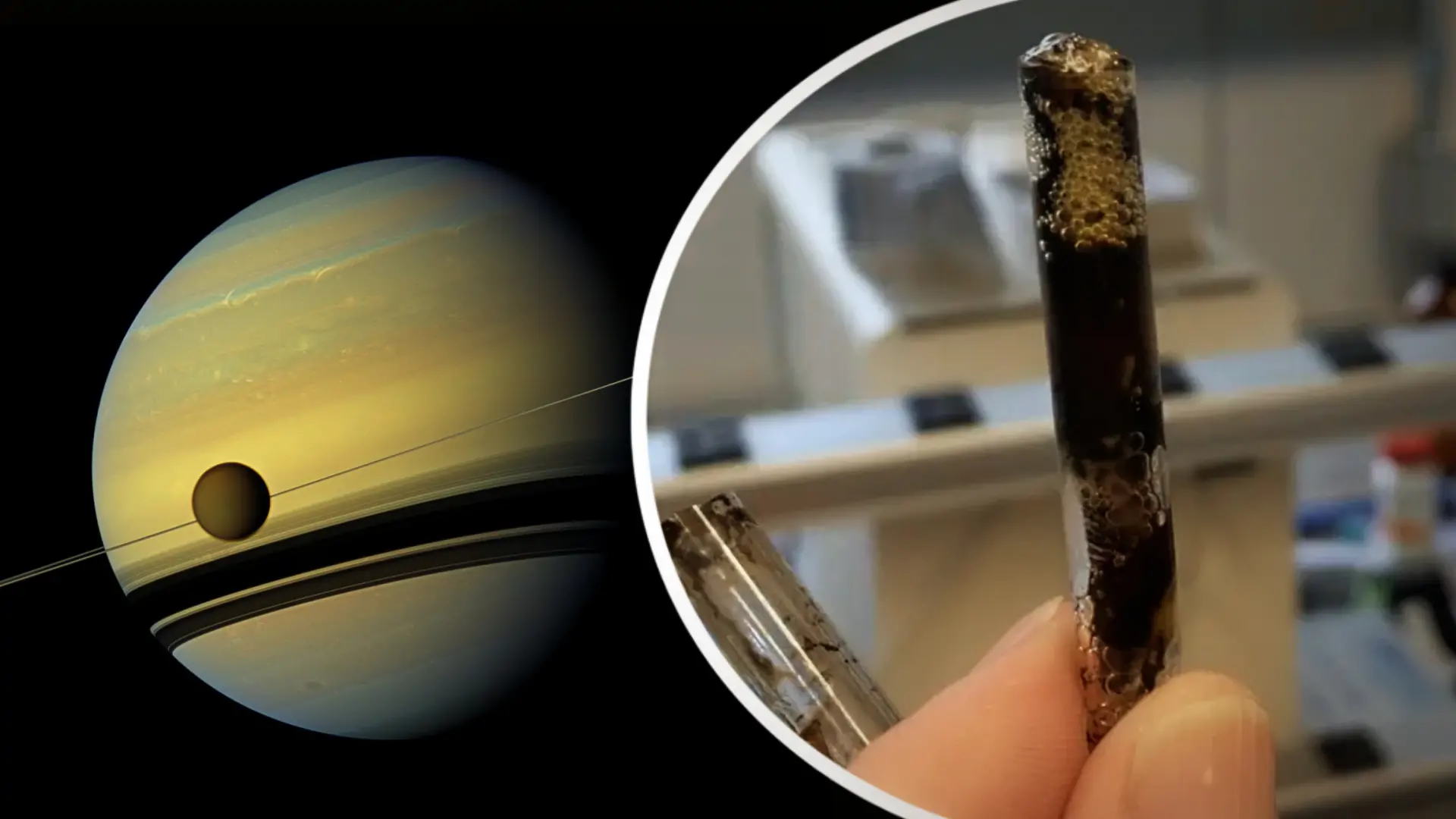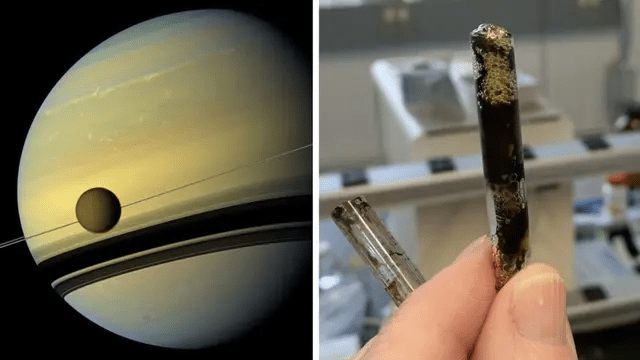Tiny Tube Experiments Recreate Titan’s Atmospheric Mystery, Revealing Insights into Our Solar System’s Only Moon with a Significant Atmosphere

Exploring the Enigmatic Titan
When it comes to moons in our solar system, few are as captivating as Titan, Saturn’s largest moon. Not only is Titan unique because of its size, but it’s also the only moon with a thick, nitrogen-rich atmosphere—something that sets it apart from every other satellite in our solar system. Scientists have long wondered why Titan has such a dense atmosphere, and recent laboratory experiments are providing groundbreaking insights into this cosmic mystery.
In collaboration with the Carnegie Institution for Science, Southwest Research Institute (SwRI) has conducted a series of intriguing experiments that recreate Titan’s atmospheric conditions in miniature form. These tiny tube experiments simulate the intense pressure and heat found beneath Titan’s surface, offering clues about how the moon maintains its life-sustaining atmosphere.

Titan: The Only Moon with a Significant Atmosphere
Titan has captured the scientific community’s attention for multiple reasons. First, it’s the only moon known to have a substantial atmosphere, which is primarily made up of nitrogen and methane. In fact, its atmosphere is about 1.5 times denser than Earth’s, even though Titan is much smaller and has lower gravity.
These experiments are crucial for understanding not only the composition and evolution of Titan’s atmosphere but also the possibility that it could have once supported microbial life. Some scientists even speculate that Titan may harbor the ingredients for life as we know it—or at least for life as we don’t know it.
If you’re curious to dive deeper into the specifics of Titan’s atmosphere, this article on NASA’s Titan mission provides extensive details on the space agency’s exploration of the moon.
Unveiling the Mysteries of Titan’s Atmosphere
SwRI scientists, including Dr. Kelly Miller, the lead author of a recent study published in Geochimica et Cosmochimica Acta, have long been intrigued by the mystery of Titan’s dense atmosphere. While Titan is just 40% the diameter of Earth, its atmosphere is far thicker than our own. For comparison, walking on Titan would feel much like scuba diving on Earth—due to the immense atmospheric pressure.
This dense layer is mostly nitrogen (around 95%) with methane making up the remaining 5%. The presence of methane is especially significant, as it’s a key player in maintaining Titan’s atmosphere. However, the methane in the atmosphere is continuously broken down by sunlight, and scientists predict that without replenishment, it would be gone in about 30 million years, causing the atmosphere to freeze onto the surface. This has led to the hypothesis that an internal process replenishes the methane and other gases, keeping the atmosphere alive.
For a deeper dive into Titan’s methane cycle, check out this detailed article on NASA’s Titan Atmospheric Science.
Replenishing Titan’s Atmosphere: A Groundbreaking Theory
In 2019, Dr. Miller and his colleagues proposed a theory to explain how Titan’s atmosphere might be replenished. According to their model, organic materials buried deep within Titan’s rocky interior are heated to extreme temperatures. This heat causes the materials to release nitrogen and methane, which then escape through the surface, replenishing the atmosphere and maintaining its thick composition.
This theory was first proposed in a paper published in The Astrophysical Journal in 2019. The team’s hypothesis is supported by the fact that Titan’s surface is not cold enough to account for the atmospheric replenishment on its own. Instead, they suggest that the moon’s internal heat—likely generated by tidal forces from Saturn’s gravity—plays a crucial role in producing the gases that keep Titan’s atmosphere intact.
Tiny Tube Experiments: Recreating Titan’s Harsh Conditions
The SwRI and Carnegie teams took this theory a step further by conducting a series of laboratory experiments aimed at recreating the extreme conditions found on Titan. To do this, they placed organic materials inside tiny vials and subjected them to temperatures between 250°C and 500°C (482°F to 932°F). The vials were also placed under extreme pressure, up to 10 kilobars (nearly 10,000 times Earth’s atmospheric pressure at sea level).
The goal of these experiments was to simulate the interior of Titan and test the hypothesis that internal heating leads to the release of gases such as methane and nitrogen, which would then escape through Titan’s surface and contribute to the replenishment of its atmosphere.
How These Experiments Are Changing Our Understanding
These tiny tube experiments have provided compelling evidence to support the idea that Titan’s atmosphere is constantly being replenished from its interior. By simulating the moon’s internal conditions, scientists have shown that organic materials can release nitrogen and methane under conditions similar to those found on Titan. This breakthrough finding is essential in explaining how Titan maintains its dense atmosphere despite the ongoing loss of methane due to sunlight-driven reactions.
The experiments also reinforce the notion that Titan’s atmosphere is not a static feature but rather a dynamic system, constantly evolving over time. It’s a glimpse into the moon’s active geological processes that are still shaping its atmosphere and surface.
The Search for Life: Titan as a Potential Host for Microbial Life
One of the most exciting aspects of Titan’s atmosphere is the possibility that it may once have harbored microbial life. While conditions on Titan today are extremely harsh—temperatures are frigid, and the surface is covered in lakes of liquid methane—scientists are intrigued by the idea that life might have existed in some form in Titan’s past.
Because Titan’s atmosphere is rich in organic compounds, it has long been a subject of study for astrobiologists looking for clues about the origins of life. The building blocks of life as we know it—such as amino acids—have been detected in Titan’s atmosphere, suggesting that the moon could have once provided an environment conducive to life, or at least the conditions for it to emerge.
For those interested in the potential for life on Titan, this article from NASA Astrobiology provides more information on how scientists are studying extreme environments on Titan to understand the possibilities for life beyond Earth.
Titan’s Role in the Broader Context of Planetary Science
Understanding Titan’s atmospheric dynamics isn’t just important for unravelling the mysteries of one moon—it also has implications for planetary science as a whole. By studying Titan, scientists gain valuable insights into the processes that govern the evolution of planetary atmospheres and the potential for life in other parts of the solar system and beyond.
Titan is often compared to early Earth, as both worlds share some key characteristics, such as a dense atmosphere and the presence of organic compounds. This has led to the idea that studying Titan’s atmosphere could provide clues about how Earth’s own atmosphere evolved and how life may have arisen here.
If you’re interested in how Titan compares to early Earth, NASA’s Planetary Science Division offers more resources on this fascinating topic.
Conclusion: Titan, the Enigmatic Moon, Continues to Inspire Exploration
As scientists continue to delve into Titan’s secrets, the moon remains one of the most exciting objects in our solar system. The recent experiments conducted by SwRI and Carnegie have shed light on the complex processes that sustain Titan’s thick, nitrogen-rich atmosphere. These findings not only enhance our understanding of Titan itself but also offer broader insights into planetary formation and the potential for life elsewhere in the universe.
With future missions, such as NASA’s Dragonfly mission to Titan, on the horizon, we can expect even more exciting discoveries about this enigmatic moon. Titan’s mysteries are far from solved, and the experiments underway today are only the beginning of a deeper exploration of one of the solar system’s most intriguing worlds.






